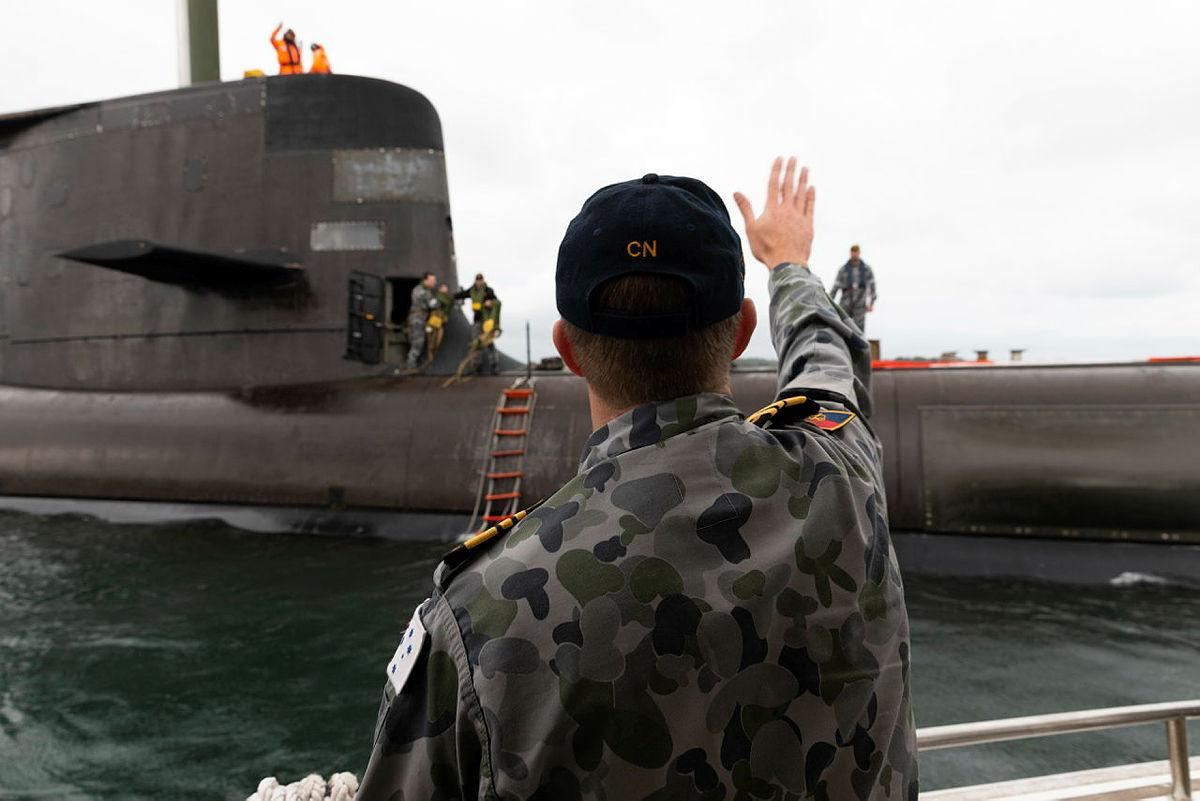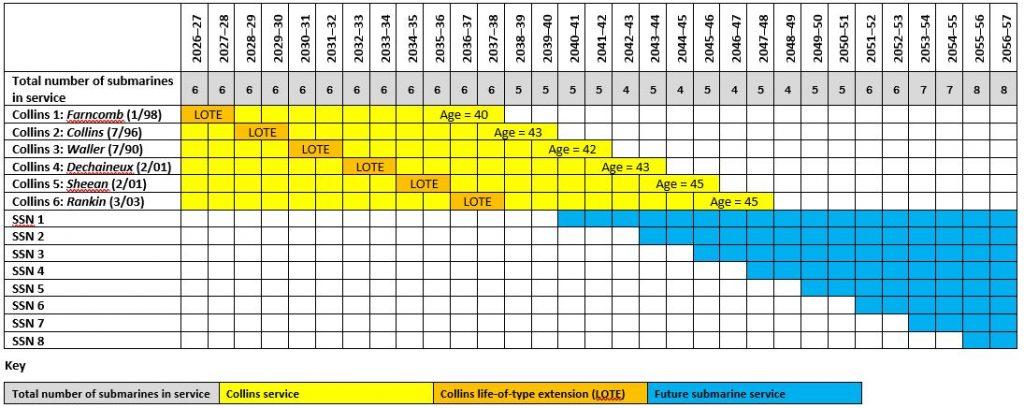
In our most recent article, we argued that the Australian government should widen the aperture of the lens through which it is scrutinising industrial strategies for acquiring and sustaining Australia’s nuclear-powered attack submarine (SSN) capability. We suggested that there are good reasons to consider building the submarines overseas.
But the government, when taking all elements of the wicked submarine problem into account, may choose to build the SSNs in Australia. Building here may deliver significant sustainment benefits. It may be necessary to develop the expertise needed to exercise responsible nuclear stewardship. Our strategic partner in the US or the UK may not have the capacity to build submarines for us. These are all issues that the nuclear-powered submarine taskforce will need to assess in preparing its advice to the government.
Whichever industrial path the government chooses, we are looking at a very long transition from the Collins class to the future SSN fleet. There are many key milestones on that path, and while most attention is directed towards when the first boat will arrive, that’s not necessarily the most important one; a single boat does not a capability make.
All capability transitions are difficult and the submarine one will be the most challenging that the Department of Defence (and the nation) has ever undertaken. It’s impossible to prepare for that transition without knowing how long the journey will last—and it will extend well past delivery of the first boat.
Our starting point is that an SSN has a useful life of 30–35 years. The Royal Navy’s most recent Trafalgar-class retirees were over 30. The most recent US Navy Los Angeles–class SSNs to be retired have averaged around 35 years of service. Some, like USS Bremerton and USS Jacksonville, served for 40 years. It’s true that in the 1990s and 2000s, some were retired at a much younger age as the US, like all Western countries, sought to harvest the post–Cold War peace dividend. But that’s not the world we are facing now. Western navies desperately need submarines and, considering the huge investment required, they want to maximise the return.
What does that mean for the schedule of a potential Australian build program? Let’s start with a continuous build program, that is, one that rolls straight into the replacement project once the first one is finished so that there are no ‘valleys of death’ in which production stops, workers are laid off and key skills are lost. Eliminating the ‘stop-start’ nature of Australian naval shipbuilding was one of the main goals of the previous government’s continuous naval shipbuilding program.
But such a program has disadvantages. One of the reasons that support for the 12-boat Attack-class program evaporated was the growing realisation that its two-year delivery drumbeat to support a continuous build program meant the new capability would be delivered too slowly, either to meet Australia’s worsening strategic circumstances or to mitigate the risk of a capability gap as the Collins aged out.
But the SSN drumbeat will likely be even slower than the Attack class was set to be. The previous government announced it would acquire ‘at least’ eight SSNs. If we assume a service life of 30–35 years for our SSNs, a continuous build program for a fleet of eight boats would require a four-year delivery drumbeat to stretch the program out so that the there’s no gap between the last boat of the initial build program and the first boat of the successor program. For a fleet of 10 boats, it would be between three and three-and-a-half years.
That’s borne out by the experience of the UK. The RN has a combined fleet of 11 nuclear boats between its SSNs and ballistic-missile submarines (SSBNs), which means it implements a delivery drumbeat to support a continuous build enterprise that alternates between SSN and SSBN programs (the Astute-class SSN program is nearing completion as the Dreadnought-class SSBN program ramps up).
But that delivery drumbeat has implications for capability (and the lack of it). If we assume the first boat is delivered in the late 2030s and enters service in 2040, that means boat two is between three and four years later—around 2043–44—and the third boat somewhere around 2046–48. If we assume the rule of threes (three vessels, squadrons, brigades, etc. are needed to reliably deploy one), then Australia won’t have an SSN capability until the second half of the 2040s, which is a quarter of a century away. That’s also the point at which the last of the Collins will reach its retirement date after having completed its life-of-type extension in 2038. We’d need to be confident that three SSNs would be a sufficient capability to move to the post-Collins world.
Table 1: Submarine transition plan—first SSN in service by 2040 (three-year drumbeat)
[click on image to enlarge]

The worst case, building on a four-year drumbeat to replace the first SSN when it is around 30 years old, means we wouldn’t have the full capability until close to 2070. That’s a really long way away.
Table 2: Submarine transition plan—first SSN in service by 2040 (four-year drumbeat)
[click on image to enlarge]

To achieve the full capability sooner, we could aim to build the SSNs faster than a three- or four-year drumbeat. On a two-year drumbeat we’d get the eighth boat in the mid- to late 2050s. Then there’s the question of whether that can actually be achieved. A Block V Virginia-class SSN is over 10,000 tonnes. The next generation of US Navy SSNs will be even bigger. That’s a lot of boat to build.
But even if we can achieve it, building faster also breaks the continuous build program. If we are building an eight-boat fleet on a two-year drumbeat, the last one arrives 14 years after the first, well before it’s time to replace it. You could retire and replace the first boat when it’s 16 years old, but only halfway through its economic life. Or you could keep the early boats in service and add to them, creating a bigger fleet. But that comes at a massive financial cost. If the RN can only afford seven SSNs, can we afford the 15 or more needed to support a two-year production drumbeat?
Table 3: Submarine transition plan—economic-build approach with first SSN in service by 2040 (two-year drumbeat)
[click on image to enlarge]

The other option is to stop building at eight or 10. But then we’d be back into the stop-start approach to shipbuilding that the previous government’s continuous naval shipbuilding program sought to address. We would be building in a valley of death from the outset.
How do we break out of this conundrum? One possibility is to not go down the path of building boats here in the first place and instead adopt the enterprise approach discussed in our previous post, which of course assumes our major partner has the capacity to build our boats for us. But even that approach will likely get us well into the 2050s by the time we have a full SSN capability.
Whichever way we look at it, we are facing a long transition, one that could potentially last into the 2060s. That fact has to be a central tenet of our planning. Once we accept that, we can chart a course that addresses any capability risks presented by the extended timeframe. The most obvious of those risks is the Collins class ageing out before the SSN capability is serviceable.
Defence Minister Richard Marles has said his mind is open on how to bridge a capability gap. There are a range of options. In our next post, we’ll start our consideration of the one that has attracted the most attention to date—a new conventional submarine.